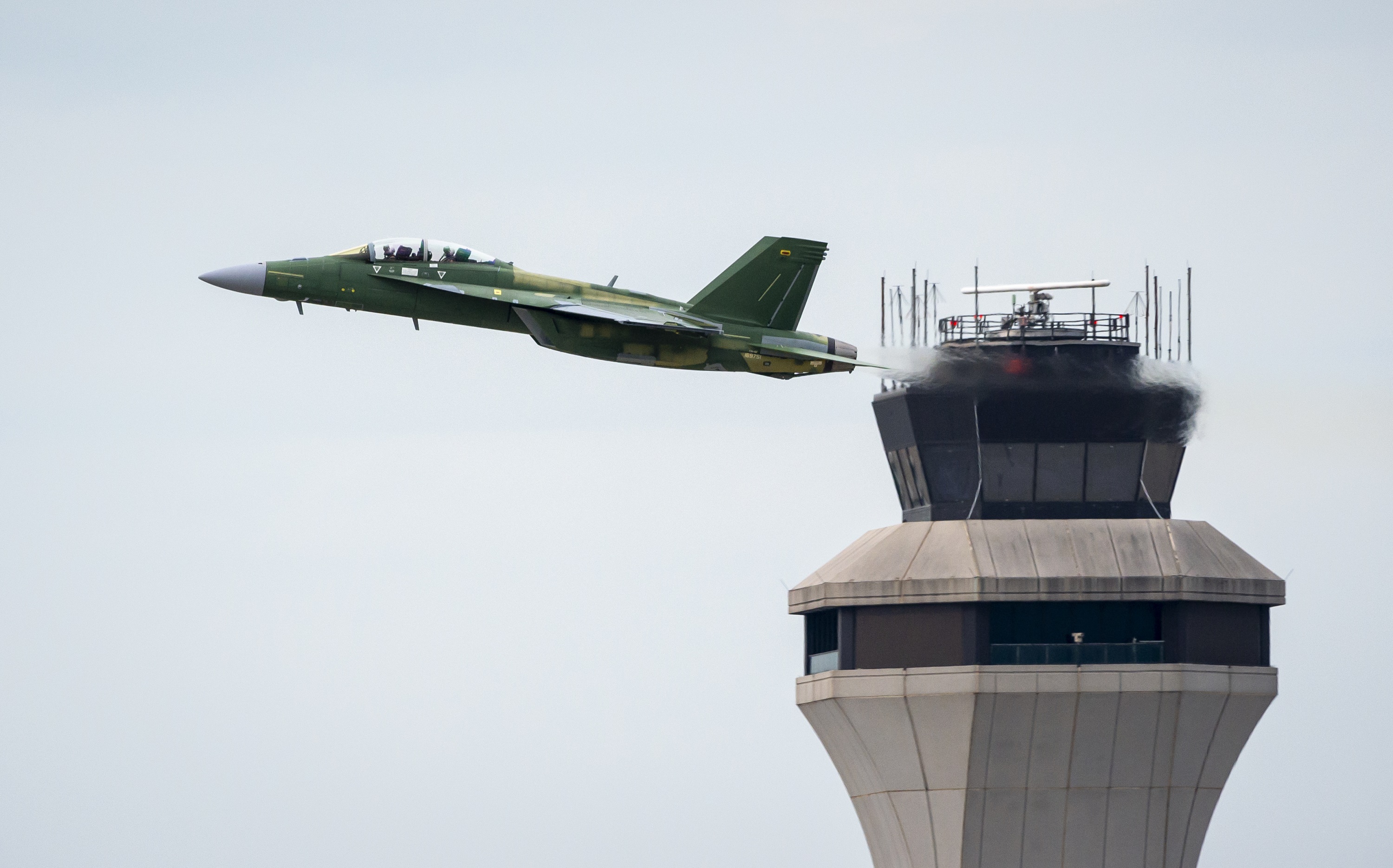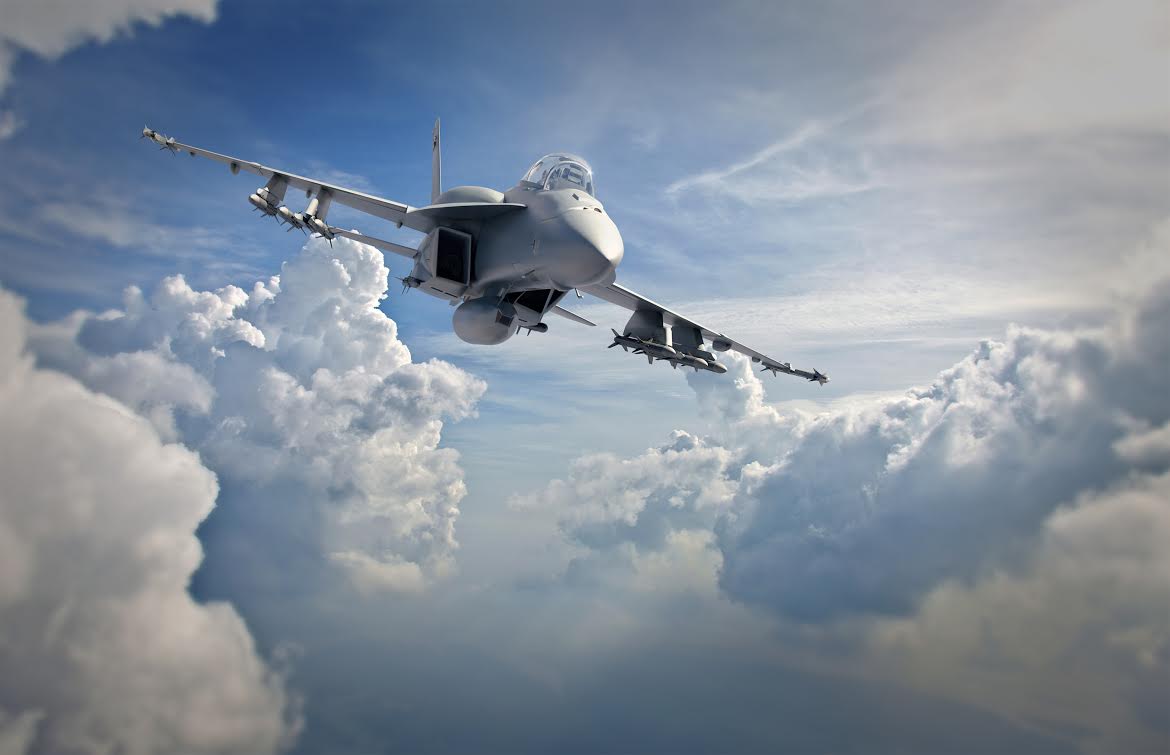
The Navy has accepted delivery of its first two Block III Super Hornets to begin testing, even as the pressure is on to decide within the next year or so what its path forward is with continuing to buy new jets from manufacturer Boeing or focusing on developing a next-generation aircraft.
Boeing announced today that it had delivered the first two F/A-18 Block III Super Hornets to the U.S. Navy for flight testing, one of which is a single-seat E model and the other a two-seat F model.
The Block III model is more “networked and survivable” compared to the Block II design, Jennifer Tebo, Boeing director of development for F/A-18 and EA-18G programs, told reporters on a media call today.
The block upgrade includes five major design features: an advanced cockpit system that combines legacy displays into a single glass touchscreen for easier use; conformal fuel tanks that add about 3,500 more pounds of fuel-carrying capacity to the jet to give it the range of the rest of the carrier air wing; a 10,000 flight hour service life, compared to about 6,000 hours previously; radar cross section improvements to make the jets even harder to find as enemy systems grow in sophistication; and an advanced networking infrastructure that includes a distributed targeting network processor to add computing power to the jet and process data faster to aid the pilot in decision-making.
The Navy is buying 78 new jets in this configuration in a multiyear contract that ends next year, and it is also backfitting its entire Block II fleet to have the Block III capabilities in a service life modification (SLM) program.
Tebo said during the call today that the first test flight of a Block III Super Hornet took place on May 14, and that the Navy has now received its first two jets to begin conducting carrier suitability testing, mission systems checkout and air crew familiarization. The Navy will spend about a year putting the jets through its test program, and around this time next year Boeing will begin delivering the new-build Block III planes at a rate of two a month through early 2024.
At the same time, though, the Navy’s plans for the future of its fighter force are somewhat murky. In 2019, Boeing won a $4-billion multiyear contract to buy 78 Super Hornets through Fiscal Year 2021, which is the budget request the Navy submitted in February and is going through congressional committees now for markups and eventual votes. However, in the February budget request release, the Navy stated that, starting in FY 2022, the money planned for a subsequent multiyear buy of 36 Super Hornets from FY 2022 to 2024 would be rerouted to “accelerated development of Next Generation Air Dominance (NGAD) and other key aviation wholeness investments,” according to budget justification documents.
Additionally, Navy acquisition chief James Geurts told USNI News in March that the decision to truncate the Super Hornet production line wasn’t about money; rather, he said, it was about freeing up the Boeing production line and workforce to focus on the SLM program, which would retain the right balance of Super Hornets versus F-35 Joint Strike Fighters in the carrier air wing and would also deliver greater capability and more service life on those converted jets.
The service in 2015 announced its intent to end its Super Hornet buys in its budget request, but then it included F-18 jets in its unfunded priorities list just weeks later in a bid to stave off a fighter shortfall due to using up flight hours faster than planned, creating confusion for the St. Louis-based production line that needed to make decisions about its future viability. Lawmakers gave the Navy money to keep buying the jets in FY 2016. In its FY 2017 request, though, the Navy again asked for money to buy a couple more jets but then would cancel the program in 2018. It later reversed that decision after acknowledging an ongoing fighter shortfall that needed to be addressed. This is the first time the Navy has tried to cancel the Super Hornet production line since 2017.
If Congress hadn’t intervened in 2015, though, and the Navy had stopped its F-18 buys, there likely weren’t enough foreign sales opportunities to keep the program afloat, and the production line would have shuttered.

Asked what the outlook is today – with the Navy again wanting to end its buys and a handful of potential international deals at play but not yet inked – Tebo told USNI News during the call that this upcoming FY 2022 budget cycle would likely determine the future of the production line.
“We kind of feel like we’ve been here before,” Tebo said.
“We’re working with the Navy as they’re looking at their force structure and providing as much information as we can to support their decision-making process. We believe the next budget cycle is really when this decision needs to be made domestically in order to not have to do anything outside the norm to keep the production line warm or alive and support international. So we’re working with them constantly on it, we feel very optimistic about it and we’ll continue to do that.”
Tebo expressed confidence during the call that the Navy might reverse its decision. Prior to the FY 2021 budget release, the plan of record included another multiyear contract that covered 36 jets over three years.
“The Navy said during a budget briefing (in February) that they still hadn’t completed their full force structure assessment yet and they’re still working on that. And they’ve even alluded to the fact that the numbers in the [five-year Future Years Defense Program] might change,” Tebo said.
“And we of course believe that the Navy does need more Super Hornets beyond what they’re planning on today to support the right force structure and be the preeminent strike fighter going forward for decades to come. So we are constantly talking to the Navy about that, providing them data and trying to give them what we think is the right balance of capability, capacity and cost for not just the Super Hornet but for the entire force structure.”
The 78 Block III jets the Navy bought in its multiyear contract should deliver by April 2024, according to the contract announcement from 2019. Additionally, production line capability is being used for the Block III SLM conversions, which will start delivering the first converted aircraft in 2023 and will continue through the mid-2030s, Tebo said during the call.
Additionally, Thom Breckenridge, Boeing vice president of international sales for strike, surveillance and mobility, told USNI News that he was confident foreign sales could supplement any domestic work and help keep the production line open.
Five open competitions are ongoing that he could talk about – in Canada, Germany, Finland, Switzerland and India – and there are other business opportunities that have not been publicly announced that he could not address, he said during the media call.
“We’re likewise very optimistic. Partly because of the significant investment in the Block III evolution, there is a lot of interest in the F-18 and obviously the Growler. The five big competitions that I mentioned represent an opportunity for quantities over 400 aircraft, which is obviously very sizeable – and those, again, are just the public competitions that are underway. So we feel very optimistic also on the international front in terms of the Super Hornet’s ability to win sales and contribute to the production,” he told USNI News.





